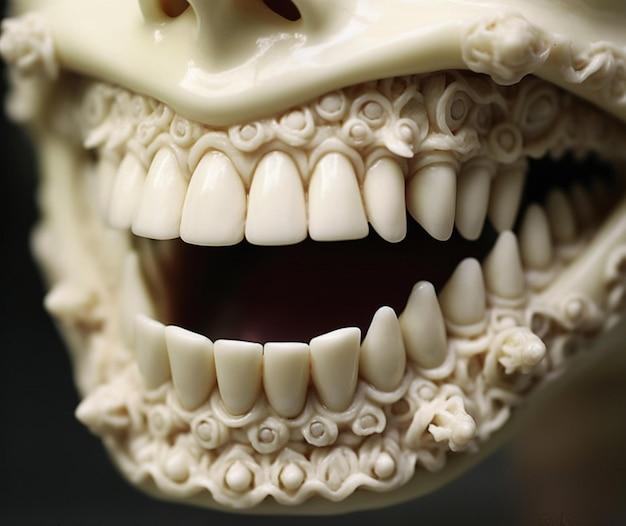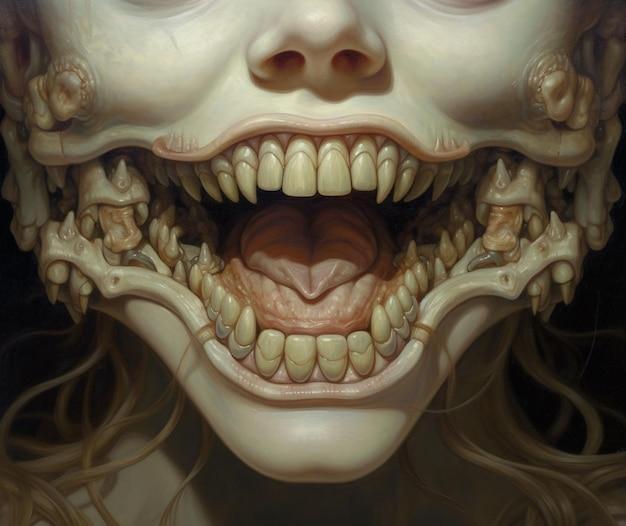Have you ever wondered if teeth are made of ivory? Ivory has long been associated with luxury and prestige, often used to create intricate sculptures, jewelry, and even musical instruments. But what exactly is ivory, and is it the same material that makes up our teeth?
In this blog post, we will delve into the fascinating world of ivory and teeth, exploring their composition, value, and unique characteristics. We’ll also answer burning questions like why some elephants are evolving without tusks, how to tell if ivory is real, and why teeth can sometimes appear yellow.
Prepare to uncover the secrets behind ivory and gain a deeper understanding of our pearly whites. So, let’s start by exploring the intriguing relationship between teeth and this highly coveted material.
Are Teeth Made Of Ivory
Teeth, those pearly whites that help us chomp through our favorite snacks and show off a winning smile. But have you ever wondered what teeth are really made of? Well, brace yourself for a journey into the realm of dental anatomy!
The Composition of Teeth
Teeth are fascinating structures composed of different materials that work together to create a strong and functional chewing apparatus. The main components of teeth include enamel, dentin, pulp, and cementum.
Enamel: The Superhero Shield
Think of enamel as the superhero shield that protects your teeth from the daily onslaught of wear and tear. It’s the hardest substance in the human body, forming a durable layer over the tooth’s surface. Made primarily of hydroxyapatite, a mineral that sounds like the wizardry of a mad scientist, enamel is responsible for keeping your teeth strong and resilient.
Dentin: The Supportive Backbone
Beneath the mighty cloak of enamel lies dentin, the supportive backbone of the tooth. Dentin is a yellowish, calcified tissue that forms most of the tooth’s structure. It’s not as tough as enamel but plays a crucial role in providing strength and support to the outer enamel shell. Dentin also contains microscopic tubules that connect with the innermost part of the tooth, called the pulp.
Pulp: The Tooth’s Heart
If teeth were characters in a romantic comedy, then the pulp would be the heartthrob stealing all the attention. Located at the core of each tooth, the pulp is a collection of nerves, blood vessels, connective tissue, and cells that keep the tooth alive and kicking. It’s where all the action happens, like sensing temperature changes or sending pain signals when you accidentally bite into something ice-cold.
Cementum: The Anchoring Hero
Now that we’ve covered the tooth’s exterior, let’s dive below the gum line to meet cementum, the unsung hero responsible for anchoring the tooth to the jawbone. Cementum is a specialized connective tissue that coats the tooth’s roots, forming a strong attachment with the periodontal ligament. With cementum in the game, your teeth stay firmly rooted, and you can confidently devour that juicy steak without any worries.
Debunking the Myth: Ivory vs. Teeth
Now, let’s get to the grand finale and unravel the truth about whether teeth are made of ivory. Drumroll, please! The answer is no. Although ivory and teeth share some similarities, they are not the same.
Ivory comes from the tusks and teeth of animals, such as elephants, walruses, and hippopotamuses. It is primarily made up of dentin, just like our teeth. However, there are significant differences between ivory and human teeth. Ivory tends to have a greater proportion of dentin compared to enamel, giving it a distinct appearance and texture.
So, while your teeth may be precious to you, they aren’t the same material as the prized ivory carvings you might find in a collector’s cabinet. You won’t be able to make a toothbrush handle out of your pearly whites and sell it for a fortune—that’s a task more suited to the majestic animals roaming the wild.
Teeth are incredible structures composed of enamel, dentin, pulp, and cementum. While they may not be made of ivory, they still deserve our admiration and care. So, take a moment to appreciate the marvels nestled within your mouth, and keep flashing that radiant smile for the world to see!
[Note: This blog post was written in 2023. Please ensure the information is up to date for the current year.]
FAQ: Are Teeth Made of Ivory
Teeth are fascinating structures that play a crucial role in our lives. They not only aid in chewing and speaking but also contribute to our overall appearance. However, when it comes to the composition of teeth, there is often confusion and curiosity surrounding the presence of ivory. In this FAQ-style subsection, we’ll address common questions about teeth and explore the connection between ivory and our pearly whites.
What spice is worth more than gold
While saffron may be pricier than gold by weight, neither gold nor saffron has anything to do with the composition of teeth. Instead, let’s focus on the intriguing connection between teeth and ivory.
Is ivory more expensive than gold
Historically, ivory has been considered a precious and sought-after material, commanding high prices. However, due to increasing global awareness and regulations banning the trade of ivory from endangered animals, its value has significantly decreased in recent years. Gold, on the other hand, remains a steadfast symbol of wealth and continues to hold its value.
What is causing elephants to evolve without tusks
The poaching crisis has forced elephants to adapt to survive. Over time, they have evolved to have a higher percentage of tuskless individuals as a result of natural selection. Elephants without tusks are less likely to be targeted by poachers, ensuring their genes are passed on to future generations. This adaptation, however, poses new challenges for these magnificent creatures.
Are teeth naturally yellow
No need to panic if your pearly whites aren’t gleaming white. Natural teeth color can vary from person to person, and a slight yellowish tint is quite common. Certain factors, such as aging, genetics, and lifestyle choices like smoking or consuming stain-causing foods and drinks, can contribute to teeth discoloration. Luckily, professional teeth whitening options are available to bring back that dazzling smile!
Do elephant tusks grow back
Unlike our teeth, which have the remarkable ability to regenerate, elephant tusks do not grow back once they are removed. This makes the conservation of elephants even more critical as their tusks are a permanent loss.
Is platinum better than gold
The debate between platinum and gold is as old as time itself. However, this question is best left to jewelry enthusiasts and metallurgists. In terms of teeth, however, ivory takes the spotlight.
Are human teeth ivory or bone
Human teeth are neither entirely ivory nor bone. They have their own unique composition. Teeth consist of a hard outer layer called enamel, an underlying layer of dentin, and a pulp-filled center containing nerves and blood vessels. While ivory and teeth have similarities, they are not interchangeable.
What is the current price of ivory
Due to global efforts to combat illegal ivory trade and protect endangered species, the sale and purchase of ivory have been heavily regulated and restricted. As a result, the price of ivory has significantly declined in recent years. However, it is essential to prioritize the conservation of elephants rather than focusing on the monetary value of their tusks.
What makes ivory so valuable
The historical allure of ivory lies in its rarity, durability, and unique grain patterns, which make it desirable for intricate carvings, jewelry, and musical instruments. However, the ethically conscious world we live in today recognizes the importance of preserving and protecting endangered species, leading to a decline in the value and demand for ivory.
How can you tell if it’s real ivory
Determining the authenticity of ivory can be challenging, requiring close examination by experts. Some common methods include assessing weight, texture, grain patterns, and response to temperature. However, it is vital to approach ivory with caution and ensure its legal and ethical origins.
What is the substitute for ivory
To meet the growing demand for ivory alternatives, various sustainable and ethical substitutes have emerged. Materials like vegetable ivory (tagua nut), bone, and synthetic alternatives provide viable options for those seeking the beauty of ivory without supporting the illegal trade or harming animal populations.
How much is real ivory worth
As mentioned earlier, the value of ivory has significantly decreased in recent years due to regulations and conservation efforts. Determining the exact worth of ivory depends on multiple factors, including quality, size, legality, and regional market dynamics. However, it is crucial to understand that promoting the preservation of elephants far outweighs any monetary value placed on their tusks.
What is the difference between ivory and teeth
While both ivory and teeth comprise dentin and enamel, the key difference lies in their composition and properties. Ivory possesses a more complex structure, making it more dense and visually distinct. Human teeth, on the other hand, exhibit natural color variations and have a structure uniquely tailored to perform their vital functions.
Can an elephant survive without tusks
Elephants rely on their tusks for numerous tasks, such as digging for water, defending themselves, and obtaining food. While tuskless elephants have adapted to survive, their ability to function without tusks is compromised. It is vital to protect these majestic creatures and preserve their natural attributes.
Is diamond worth more than gold
Diamonds may be a girl’s best friend, but in terms of comparing their value to that of gold, it’s like comparing apples to oranges. Each holds its own allure and value based on different factors such as rarity, demand, and subjective preferences. In the realm of teeth, however, ivory steals the limelight.
Do human teeth have ivory
Though human teeth share certain characteristics with ivory, such as their composition of dentin and enamel, it is more accurate to say that human teeth have similarities with ivory rather than containing actual ivory. Teeth are truly fascinating structures in their own right!
Why are elephants afraid of mice
Ah, the age-old myth of elephants’ fear of mice. Let’s debunk this delightful tale. Elephants are not inherently terrified of mice, despite what cartoons may lead us to believe. Their fear response is more instinctual and triggered by sudden movements or unfamiliar sounds, not by tiny rodents scurrying by!
How can you tell how old ivory is
Determining the age of ivory is a complex process that requires scientific analysis. Experts employ various methods such as radiocarbon dating, microscopic analysis, and chemical testing to estimate the age of ivory artifacts. So, unless you have access to a lab and an elephant-sized time machine, it’s best to leave this task to the professionals!
Which animals have ivory teeth
Elephants are the most famous animals known for their ivory tusks. However, they are not alone in possessing these unique structures. Other animals, such as narwhals, walruses, and certain species of pigs, also have teeth or tusks composed of ivory. Mother Nature sure knows how to create captivating dental accessories!
Who buys the most ivory
The demand for ivory has drastically declined due to increasing awareness and stringent regulations worldwide. However, it’s important to note that any demand for ivory perpetuates an illegal and harmful trade that endangers the lives of elephants. Let’s focus on celebrating these magnificent creatures rather than contributing to their demise.
What is the most intelligent animal
Ah, the age-old question of animal intelligence. While intelligence varies across species and is challenging to quantify, some animals, such as dolphins, chimpanzees, and elephants, are widely recognized for their problem-solving skills and advanced cognitive abilities. It’s a fascinating topic that continues to fuel scientific exploration!
Teeth are not made of pure ivory, but they share similarities in composition. The allure of ivory lies in its historical value, aesthetic appeal, and unique properties. However, in our ever-evolving world, it is essential to prioritize the conservation of animals and explore sustainable alternatives. So, next time you flash your pearly whites, remember the fascinating connection they have to the world of ivory!

